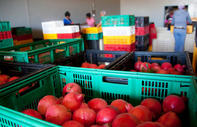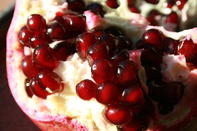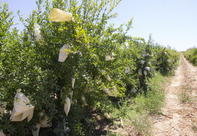More than 4 000 years ago, an apple-size leathery fruit with bright red seeds became popular in Central Asia and Persia (Iran).

Called ‘seeded apple’ (or Punica granatum in Latin), the pomegranate spread east and west through the hot, dry regions of India, Asia Minor and the Mediterranean Coast and was introduced to the Americas by Spanish traders.
Growing on small bushy trees or large shrubs, the pomegranate has a hard leathery skin and depending on the cultivar can vary in colour - from yellow and red to almost purple.
The red arils (‘seeds’) inside can be eaten fresh, juiced or processed and the skin is used in Ayurvedic and ethic medicines. The fruit is an excellent source of antioxidants and pomegranate seed oil is a rich source of punicic acid (antioxidant, anti-inflammatory) and used in natural cosmetics and skin care.
Production Statistics of Pomegranates in South Africa

Production of pomegranates in South Africa only started in the early 2000s and has grown to just over 930 hectares in 2018. Initial problems with disease-infected (black spot) plant material imported from India in 2003 was overcome and by 2005 the pomegranate industry in South Africa was starting to boom.
Pomegranate production in South Africa is mainly based in the Western Cape (80%) with some plantings in the Orange River area, Limpopo Province and the Southern Cape. Currently (2018) South Africa is one of the four major Southern Hemisphere (SH) suppliers to international markets. Main competitor countries are Peru (74% of SH exports), Chili (14%) and Argentina (4%).
From 2012 to 2017, the export of pomegranates has increased by 141%, but in 2018 exports has seen a significant (19%) drop. In 2018 only about 1,17 million cartons (3.8 kg units) were exported, compared to 1,44 million cartons in 2017. The devastating drought in 2017/2018 in the Western Cape caused this huge decline in exports.
Even though pomegranates prefer dry, warm conditions, water stress causes a reduction in fruit numbers and fruit size. The top-3 importing markets for South African pomegranates are Europe, the Middle East and the UK.
Between 2012 and 2018 exports to Russia has increased by 105% while exports to the Middle East has increased by 455%. South Africa only import pomegranates from Israel, mostly the ‘Wonderful’ variety.
Trade agreements prohibit the importing of pomegranates from countries such as Spain and Italy where superior varieties are produced. Some of these varieties such as ‘Big Fool’ and ‘Kingdom’ are already tested (under license) in South Africa.
Packhouse statistics of the total South African production of pomegranates are as follows: about 80% exported, 11% used locally and about 9% is waste. This ‘waste’ is mainly cracked and diseased fruit, unsuitable even for juicing. Most of these ‘waste’ fruit are used for feeding cattle and pigs.
The main pomegranate export cultivars grown in South Africa are late-ripening Wonderful (68%), mid-season Herskovitz (14%) and early cultivar Acco (10%). Kessari/Baghwa is the pomegranate mostly sold in South Africa as the quality is not consistently good enough for exports.
Most new plantings of pomegranates in South Africa are localised in the Limpopo regions where 250 - 300 hectares are planned for planting in 2019. Fruit from Limpopo can be harvested by the end of January, which will be able to reach Northern Hemisphere markets before fruit from competition countries such as Peru.
The newly planted pomegranate orchards consist mostly of cultivars Wonderful and Acco. In the Western Cape, plantings of ‘Angel Red’ (an American cultivar) is increasing.
Growing of Pomegranates

Pomegranates prefer a Mediterranean climate - colder winters and hot summers. It is sensitive to wind and frost. Humid climates may contribute to fungal diseases. Trees need pruning and benefit from irrigation and thinning out of fruit clusters after fruit set. (Fruit set is when new fruit is just beginning to take shape after flowering).
Pomegranates must be protected against pests (false codling moth, aphids, mealybug, scale, thrips, mites, whitefly, nematodes) and diseases. Physiological issues can include internal breakdown, fruit cracking, chilling injury and deformed fruit.
Pomegranate trees grow and bear fruit for over 30 years. Proper planning, soil preparation, irrigation systems and cultivar selection is necessary before establishing a pomegranate orchard.
Commercial production requires specialised agricultural practices and is done by experienced fruit producers. Pomegranate Producers Association of South Africa (POMASA) was established in 2009 and coordinates the information exchange between pomegranate growers, processors, marketing agents, nurseries and researchers in South Africa.
Limitations of Growing Pomegranates
Growing pomegranates in South Africa may be constrained by the availability and quality of water, the climate in certain areas and a lack of skills and knowledge in new farmers.
More research into better pest and disease control methods, new cultivars and improved technology such as specialised pack stores and a wider range of registered chemicals will increase the export potential of South African pomegranates.
By Marinda LouwFor bulk or Pomegranate export enquiries please use the enquiry link below.